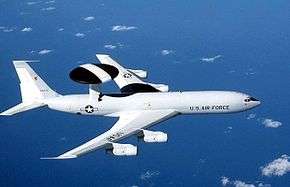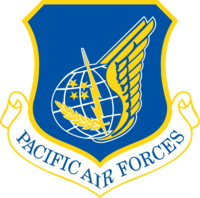962d Airborne Air Control Squadron
| 962d Airborne Air Control Squadron | |
|---|---|
|
962d Airborne Air Control Squadron Patch | |
| Active |
1 November 1943 - 28 August 1945 8 July 1955 - 31 December 1969 1 July 1986 - Present |
| Country | United States |
| Branch | United States Air Force |
| Type | Airborne Command and Control |
| Part of |
Pacific Air Forces 11th Air Force 3rd Wing 3rd Operations Group |
| Garrison/HQ | Elmendorf Air Force Base |
| Motto(s) | Eyes of the Eagle |
| Decorations |
|


The 962d Airborne Air Control Squadron (962 AACS) is part of the 3rd Wing at Elmendorf Air Force Base, Alaska. It operates the E-3 Sentry aircraft conducting airborne command and control missions.
Mission
The 962d Airborne Air Control Squadron provides the commander, U.S. Pacific Command, with a long-range airborne surveillance, detection, identification, and command and control platform for both local and deployed composite wing operations. It supports the commander's, North American Aerospace Defense Command (NORAD), commitment to defense of the Alaskan Region.[1]
History
Established in late 1943 as a B-24 Liberator heavy bombardment squadrons; assigned to II Bomber Command for training. One of the last heavy bomb squadrons activated, the unit trained at McCook Army Airfield, Nebraska in a "hurry up" mode, as B-29 Superfortress training was being conducted by Second Air Force and heavy bomber training was rapidly being phased out. Intensive training of all airmen and support specialists began in January and was only occasionally interrupted by Nebraska's late winter and early spring storms. Air exercises in several models of B-24s included day and night flights, cross-country navigation, simulated bombing, aerial-gunnery practice, and squadron and group formation flying.
The unit was deployed to the European Theater of Operations (ETO), being assigned to VIII Bomber Command in England. Was assigned to RAF Debach though the balance of the war, with a temporary move to RAF Wormingford in early 1945 while runways were being repaired at Debach. While at Wormingford, the squadron flew unarmed weather reconnaissance flights in support of Eighth Air Force combat operations mission planning. Combat aircraft included B-24Hs and B-24Js from June 6 to August 24, 1944, and B-17Gs from September 8, 1944 to April 20, 1945.
Missions involved engaging in very long range strategic bombardment attacks on Nazi Germany and Occupied Europe, striking airfields, bridges, and gun batteries prior to and during the invasion of Normandy in June 1944; hitting enemy positions to assist ground forces south of Caen and at Saint-Lô in July 1944; bombing German fortifications to cover the airborne attack on the Netherlands in September 1944; attacking enemy communications during the Battle of the Bulge, December 1944-January 1945; and assisting the airborne assault across the Rhine in March 1945. The squadron flew its last combat mission, an attack on marshalling yards at Nauen, on 20 April 1945.
The squadron redeployed to the United States. in July and August 1945 and was established at Sioux Falls Army Air Field, South Dakota on August 12 for B-29 training, however the Japanese Capitulation negated the need for the unit to train in B-29s and re-deploy to the Pacific Theater. The personnel were demobilized and the unit was inactivated there on August 28, 1945.[2]
The 962d was reactivated on 8 July 1955, as a unit of the 551st Airborne Early Warning and Control Wing, with headquarters at Otis Air Force Base, Massachusetts. The squadron, equipped with various models of the propeller-driven C-121 Constellation aircraft, was a unit of the Air Defense Command.[1]
The 962d participated in numerous operations to test the capability and readiness of the early warning system in order to extend radar coverage seaward beyond that provided by land radars. The unit provided navigational and communications assistance to U.S. and allied aircraft crossing the Atlantic Ocean and to units operating near Cape Canaveral, Florida.[1]
As an operational unit of the 551st Airborne Early Warning and Control Wing from 1955 to 1969, one of the 962's missions was to conduct search and rescue operations. One result of this role was the popularization of search operation patterns used while searching for a missing U.S. Navy aircraft in late February 1958.[1]
The unit was inactivated on 31 December 1969. Having been re-designated as the 962d Airborne Warning and Control Squadron, the unit was reactivated on 8 July 1986, at Elmendorf Air Force Base in support of the Alaskan NORAD Region. A tenant unit of the 21st Tactical Fighter Wing, the 962 AWACS was assigned to the 552nd Air Control Wing, Tactical Air Command, with headquarters at Tinker Air Force Base, Oklahoma.[1]
The mission of the 962 AWACS was to provide the 11th Air Force/Alaskan NORAD Region commander with a survivable radar platform that can extend the surveillance coverage of the land-based radar system operated by the Regional Operational Control Center. This enables battle commanders to see a threat at previously undetectable ranges and to position fighters to intercept them before they approach U.S. airspace. Since 1986, the squadron assisted in the interception of 68 Soviet aircraft.[1]
In October 1992, the squadron was redesignated to the 3rd Wing, Elmendorf AFB, under Pacific Air Forces, and acquired the additional mission of being ready to deploy in support of commander, Pacific Command. In August 1994, the 962 AWACS was re-designated the 962 AACS.[1]
On 22 September 1995, the squadron experienced its worst single accident. Aircraft Yukla 27 rolled for takeoff at 0746 Alaska Standard Time (AST) remaining airborne only 42 seconds due to a massive bird strike resulting in catastrophic damage. The crash resulted in the deaths of 22 U.S. Air Force and 2 Canadian Air Force personnel.[1]
Today, squadron aircrews take part in exercises such as Red Flag - Alaska, TEAM SPIRIT, GREEN FLAG, and TANDEM THRUST.[1]
Lineage[2]
- Constituted 862 Bombardment Squadron (Heavy) on 14 Sept 1943
- Activated on 1 Nov 1943
- Redesignated 862 Bombardment Squadron, Heavy, on 21 Feb 1944
- Inactivated on 28 Aug 1945
- Consolidated (19 Sept 1985) with the 962 Airborne Early Warning and Control Squadron, which was constituted on 30 Mar 1955.
- Activated on 8 Jul 1955
- Inactivated on 31 Dec 1969
- Redesignated: 962 Airborne Warning and Control Support Squadron on 31 Jul 1979
- Redesignated: 962 Airborne Warning and Control Squadron on 19 Sept 1985
- Activated on 1 Jul 1986
- Redesignated 962 Airborne Air Control Squadron on 1 Aug 1994.
Assignments[2]
- 493d Bombardment Group, 1 Nov 1943-28 Aug 1945
- Attached to 3rd Air Division, 17 Feb-7 May 1945
- 551st Airborne Early Warning and Control Wing, 8 Jul 1955-31 Dec 1969
- 28th Air Division, 1 Jul 1986
- 552nd Operations Group, 29 May 1992
- 3rd Operations Group, 1 May 1993 – Present
Bases stationed[2]
- McCook Army Airfield, Nebraska, 1 Nov 1943-1 Jan 1944
- Elveden Hall, England, 1 Jan 1944
- RAF Debach, England, 17 Apr 1944
- RAF Wormingford, England, 17 Feb 1945
- RAF Debach, England, 18 May-6 Aug 1945
- Sioux Falls Army Air Field, South Dakota, c. 13-28 Aug 1945
- Otis AFB, Massachusetts, 8 Jul 1955-31 Dec 1969
- Elmendorf AFB, Alaska, 1 Jul 1986–Present
Aircraft Operated[2]
- B-24 Liberator (1944)
- B-17 Flying Fortress (1944–1945)
- P-51 Mustang (1945)
- C-121 Constellation (1955–1969)
- E-3 Sentry (1986–Present)
Operations[2]
References
![]() This article incorporates public domain material from the Air Force Historical Research Agency website http://www.afhra.af.mil/.
This article incorporates public domain material from the Air Force Historical Research Agency website http://www.afhra.af.mil/.
- Maurer, Maurer (1983). Air Force Combat Units Of World War II. Maxwell AFB, AL: Office of Air Force History. ISBN 0-89201-092-4.


